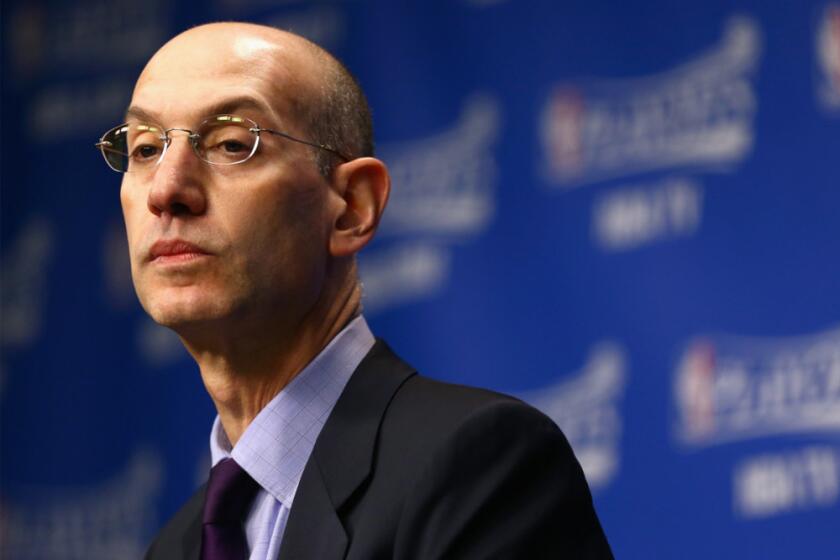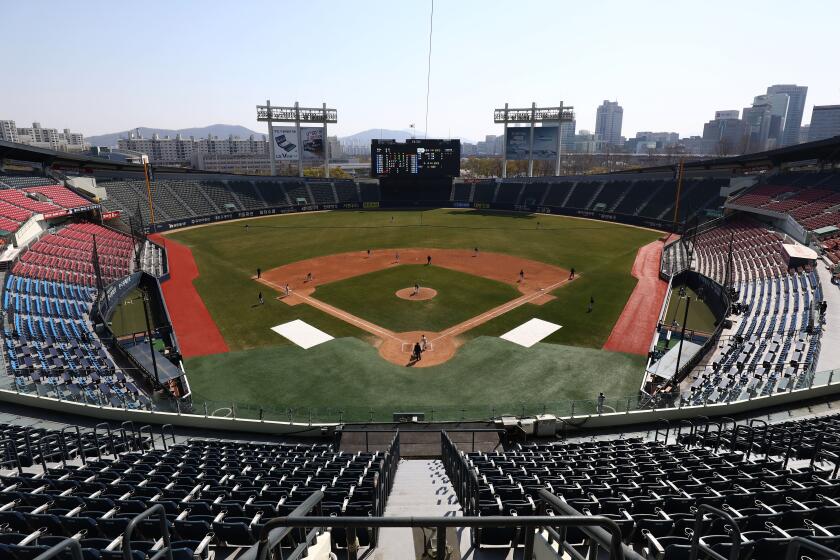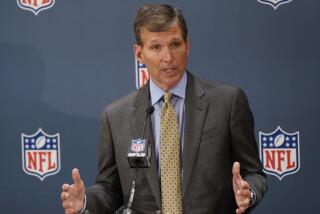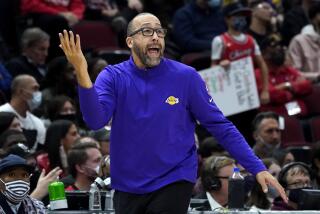The resumption of NBA season might rely on protocols not yet available
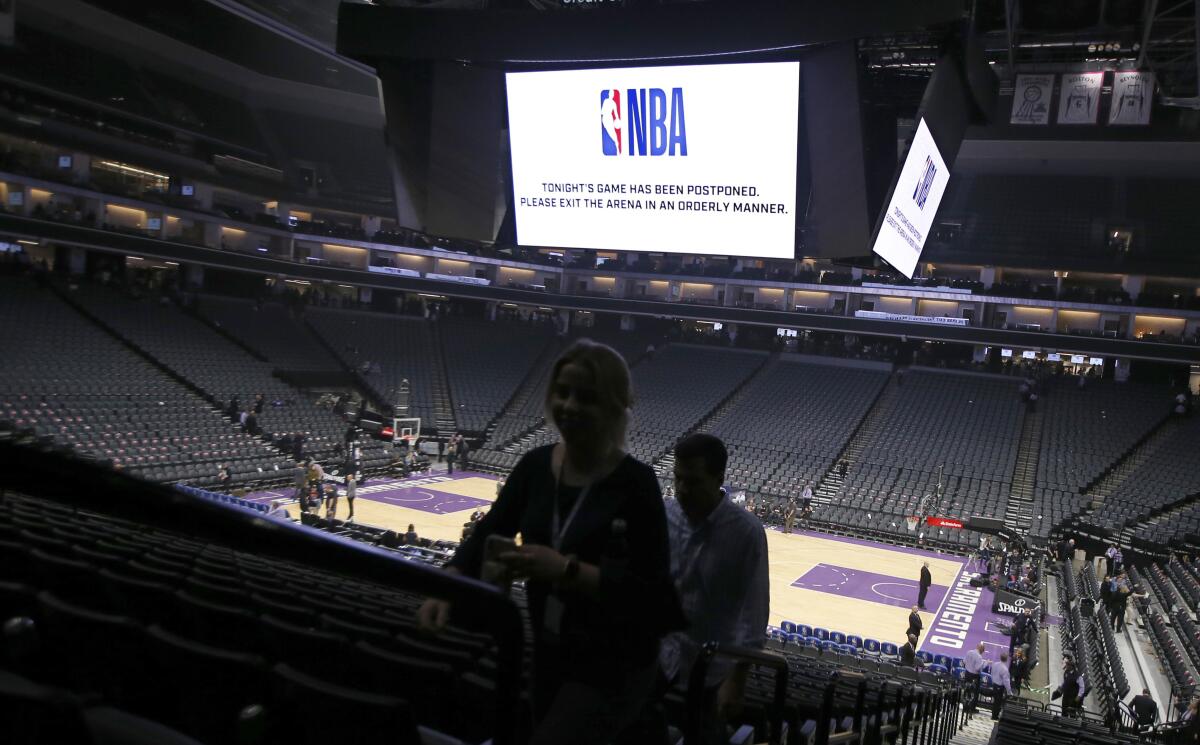
- Share via
When T.O. Souryal heard the PGA Tour planned to resume its season in June, the former Dallas Mavericks team physician didn’t think it sounded far-fetched.
Following social-distancing guidelines on a sprawling golf course, without spectators, seemed feasible. A positive test for the novel coronavirus might derail a player’s season, but not the tour’s schedule.
For the record:
6:50 a.m. April 21, 2020A previous version of the story stated Dr. T.O. Souryal served as Mavericks team physician for 27 years. It was 22.
But restarting the NBA’s 2020 season? Souryal’s experience, during 22 years as the Mavericks’ doctor and two terms as president of the league’s association of team physicians, taught him that would be a complex undertaking. The path to a resumed season remains fraught with uncertainty, including what he calls “the $64-billion question.”
“What do we do if we come back and a player tests positive?” said Souryal, the medical director at a Texas sports medicine clinic. “Until they have an answer for that, I don’t see the NBA or hockey or any other close-quarter team sport coming back anytime soon.”
Since suspending its season March 11 following a positive test by Utah center Rudy Gobert, the NBA has canvassed a former United States surgeon general, public health officials and team doctors, athletic trainers and performance coaches to understand how to get players, coaches and staffers back on the job safely, and to keep them that way.
Five weeks of discussions have yielded few answers and left the league, as well as the country, grappling with how to reopen. Commissioner Adam Silver has said the NBA is still not ready to make decisions about the 2020 season, and that a resumption would hinge on such factors as the availability of wide-scale testing, antibody therapy and vaccination.
“What most people don’t understand about a team sport is that it’s not just the 15 contract players, it’s not just the 53 NFL roster players; it’s the coaches, it’s the trainers, it’s the nutritionist, it’s the strength and conditioning, it’s the ball boys,” Souryal said. “It’s essentially a little city, and that little city leaves a great deal of risk if any one of those people gets infected. Because that little city, that little community, lives in very close quarters.
NBA Commissioner Adam Silver said there are still too many factors regarding the COVID-19 pandemic to consider when or if to resume the season.
“If one of those people tests positive, of course you’re going to quarantine that person, but what about everybody that has come in contact with that person? I don’t know that the NBA, or any other league, has an answer to that question. And I believe that question will remain a question until we have a vaccine or a pill.”
Such treatments appear to be several months away, Souryal said, in a best-case scenario. In the interim, some leagues have found ways to operate using strict measures to ensure players have not contracted the virus. Multiple daily temperature checks and gobs of hand sanitizer have become the norm for baseball players in Taiwan, which played its first games last week in empty stadiums.
That league has five teams; the NBA has 30, with each still having 15-18 games left on its regular-season schedule. Going straight into the playoffs would leave 16.
“Everybody is going to be nervous and scared and part of the problem is, throughout the 50 states, everybody’s at different stages” of the coronavirus spread, said an athletic trainer employed by an NBA team who requested anonymity because he was not authorized to speak publicly. “When can we get to this kind of position to actually play a game? That’s the first step. Then, what do we have in place? Rapid testing is just one of them. What if someone gets sick? Is there medication that’s going to work, that if someone does get ill that they could get on?
“If one of us, if we’re around a family member, one of us ends up having COVID, then you get isolated from the rest of your family and you hope they don’t get it. It’s going to be the same thing. ... You’re talking about at that point, do you shut down a team?”
Major League Baseball has considered shuttling teams between quarantined hotels and spectator-free stadiums in Arizona, and the NBA has listened to single-location proposals, too.
“This concept falls apart when the bus driver driving the bus from the airport to the hotel is positive [for coronavirus],” Souryal said. “The only way is to ensure all of those people are negative and then to keep them sequestered from any other people. There is not a foolproof way to do this.”
Santa Anita stopped racing horses last month, but hundreds of people still work, and live, in a stable area at the track under the specter of COVID-19.
Lawrence Frank, the Clippers’ president of basketball operations, said the rapid testing of players would represent a “huge boost,” according to experts. So would a test to learn which players possess the antibodies to fight the virus.
How quickly NBA teams would be able to act on these types of advances remains unknown; testing capacity continues to lag across the country. Backlash broadsided the league in March after eight teams secured testing for coronavirus at a time of nationwide shortages.
Georges Benjamin, the executive director of the American Public Health Assn., said the NBA would “have to avoid at all costs” the optics of reserving an untold number of tests, and the personal protective equipment and medical professionals to conduct them, if such resources are not yet widely available.
“Whatever they do, they have to have a plan and look at what is happening in the rest of the world,” Benjamin said. “… I’m sure most of the players believe they have a community obligation to protect the community.”
Medical experts are concerned about the players’ susceptibility to coronavirus as well as the potential for injuries following a long layoff.
Teams have helped players maintain some semblance of conditioning by delivering equipment such as stationary bikes and weights, and holding group workouts using video-chat software. But there is a difference between maintaining fitness and staying in basketball shape.
A look at how sports leagues, including the NFL, MLB, MLS, NBA and NHL, are responding to the coronavirus outbreak.
“These are the best athletes in the world, but the repetitive nature of what they do they’re just not doing at home,” said Tory Lindley, president of the National Athletic Trainers Assn. “They’re just not jumping and landing, jumping and landing to the extent that they would do in any one single pre-practice, let alone in practice. As healthcare providers, we can’t allow that to be truncated. It’d be irresponsible from a health and safety perspective.”
Lakers star LeBron James said it would take a minimum of five to 10 days to prepare for games. However, an NBA executive not authorized by his team to speak publicly suggested players would need at least three weeks of training to return to basketball shape.
Citing the NBA’s dialogue with an array of medical officials, the athletic trainer was “very confident” the league’s leadership, despite mounting financial losses, would base decisions on safety.
Return too soon and the virus spread “will come back with a vengeance,” Benjamin said.
“There are more questions than there are answers right now, and I think Adam and everybody around him is searching for the answers, but unfortunately it’s just not there yet,” Souryal said. “You can stick a Q-Tip up a player’s nose every single morning and make sure that they’re negative, but the one time one of those turns positive you gotta stop the season again, or at least that team is out.”
More to Read
Go beyond the scoreboard
Get the latest on L.A.'s teams in the daily Sports Report newsletter.
You may occasionally receive promotional content from the Los Angeles Times.

